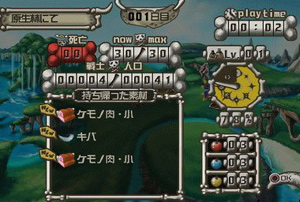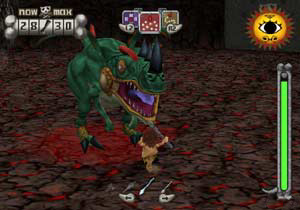Simple 2000 Series Vol. 99: The Genshijin
 What makes a successful Simple 2000 Series game? Sometimes it’s a collision of original elements that have been refined over several games, often on other publishers’ dimes. Sometimes it’s a mere port or remake of a game that’s previously found success as a full-priced release. The well-executed, original, non-franchise title is a rarity among the rare good games in D3 Publisher’s catalog. However, the necessary alignment of heavenly bodies seems to have been just right for the release of developer Vingt-et-un Systems’ April release, Simple 2000 Series Vol. 99: The Genshijin, or The Primitive Man.
What makes a successful Simple 2000 Series game? Sometimes it’s a collision of original elements that have been refined over several games, often on other publishers’ dimes. Sometimes it’s a mere port or remake of a game that’s previously found success as a full-priced release. The well-executed, original, non-franchise title is a rarity among the rare good games in D3 Publisher’s catalog. However, the necessary alignment of heavenly bodies seems to have been just right for the release of developer Vingt-et-un Systems’ April release, Simple 2000 Series Vol. 99: The Genshijin, or The Primitive Man.
The Genshijin can best be described as a combination of Nintendo’s real-time-strategy-explorer Pikmin and Artdink’s bizarro caveman-sim Tail of the Sun. As the game begins, you control a diminutive monkey living in a small monkey-village. Your monkey is ever-so-slightly bigger than the rest of the monkeys in his tribe, and therefore is able to boss other monkeys around and lead them on sorties into the great wilderness outside. The monkeys in the boss’s party follow him in formation and act on the commands he gives. They can pick up food and artifacts, attack wild beasts with their monkey-fists, and work together to surmount obstacles (which are usually great slabs of rock that serve as gates between areas).
There are five levels through which to guide your troops, and each is full of interesting obstacles and set-pieces. You’ll only have access to one level at first, of course, but you can return to any level at any time, and each level has initially-inaccessible goodies that you can retrieve if you return with better equipment. There’s a nice variety of enemies to be seen (and killed), and while it’s clear that each of a few different monster types has been recycled into several different enemies, differences in behavior and sound effects ensure that the creatures stay interesting to fight throughout the game.
 As the game progresses, you can add more monkeys to your party, and each level’s reward is a technological breakthrough that makes previously inaccessible terrain navigable. More monkeys means larger items can be picked up, since most items require more than one monkey to transport. Plus, dangerous animals can be felled more quickly. As you bring back larger and more rare items, the village grows in size, and new types of buildings become available. There are three types of materials to be collected out in the wilderness – wood, stone, and metal – and each contributes to the construction of certain structures. Among the many available to build, there’s an item shop, gyms (charmingly misspelled “Jim” in-game) for training your troops, a workshop where you can combine items to gain rare restoratives, and a cemetery that keeps count of the citizens you’ve sacrificed to the cause.
As the game progresses, you can add more monkeys to your party, and each level’s reward is a technological breakthrough that makes previously inaccessible terrain navigable. More monkeys means larger items can be picked up, since most items require more than one monkey to transport. Plus, dangerous animals can be felled more quickly. As you bring back larger and more rare items, the village grows in size, and new types of buildings become available. There are three types of materials to be collected out in the wilderness – wood, stone, and metal – and each contributes to the construction of certain structures. Among the many available to build, there’s an item shop, gyms (charmingly misspelled “Jim” in-game) for training your troops, a workshop where you can combine items to gain rare restoratives, and a cemetery that keeps count of the citizens you’ve sacrificed to the cause.
Each technological advancement pushes your tribe up the evolutionary ladder, from monkeys to apes to Neanderthals, and eventually to the titular primitive men. As your species becomes smarter, it gains access to weapons of increasing sophistication, like axes, spears, and eventually bows. No matter how advanced your tribe gets, though, each member retains that same charming scowl.
The language barrier is somewhat high here, as all the game’s menus are presented in Japanese, and there’s a large helping of flavor text included. Thankfully, though, there’s nothing necessary to succeed at the game that can’t be figured out pretty easily just by playing. Items are all represented by distinct and cute models and artwork, and the iconified, context-sensitive controls are intuitive. The Genshijin may not have inherited Pikmin’s layered complexity of mechanics, but does avoid Tail of the Sun’s obtuse nature. Here’s a tip for the Japanese-illiterate, however: make sure you follow each material’s development path to its end before completing the game. Otherwisem you’ll end up with the game’s bad ending (which is not altogether unpleasant, if you’ve got a dark sense of humor).
 The game’s control and animation are both smooth and attractive. One could be forgiven for mistaking the game for something other than a Simple 2000 budget release. Enemies are pleasantly rounded and cartoony, and the scowling tribesmen have a funny way of running and an amusing little dance that make it clear that more effort was spent on presentation here than in most Simple 2000 titles. The constraints of the game’s budget make themselves felt most noticeably here in the game’s engine – whose poor image quality the game shares with The Zombie vs. Ambulance – and in late-game troop mechanics. The poor cavemen do their best to follow their leader, but when there are fifteen or more party members in formation, it’s almost inevitable that a few of them get caught on scenery and left behind. Their pathfinding routines don’t seem to be well-developed, either, so keeping that many of them together often involves some babysitting.
The game’s control and animation are both smooth and attractive. One could be forgiven for mistaking the game for something other than a Simple 2000 budget release. Enemies are pleasantly rounded and cartoony, and the scowling tribesmen have a funny way of running and an amusing little dance that make it clear that more effort was spent on presentation here than in most Simple 2000 titles. The constraints of the game’s budget make themselves felt most noticeably here in the game’s engine – whose poor image quality the game shares with The Zombie vs. Ambulance – and in late-game troop mechanics. The poor cavemen do their best to follow their leader, but when there are fifteen or more party members in formation, it’s almost inevitable that a few of them get caught on scenery and left behind. Their pathfinding routines don’t seem to be well-developed, either, so keeping that many of them together often involves some babysitting.
The Genshijin will take the average player ten to twelve hours to complete. That’s extremely generous for a Simple 2000 title, especially when so little of that time is spent in the repetitive, looped structure that’s so common to games in this series. D3’s developers often have a hard time balancing their budget between engine development, character animation, and level design, and so they often fill their games with experience to earn and upgrades to buy, leaving the player forever grinding away. The way The Genshijin offers so much playtime while avoiding this pitfall so deftly – and supplying a series of original, interesting challenges instead – is amazing. This is one of those ‘lightning in a bottle’ examples of a D3 project gone almost completely right.